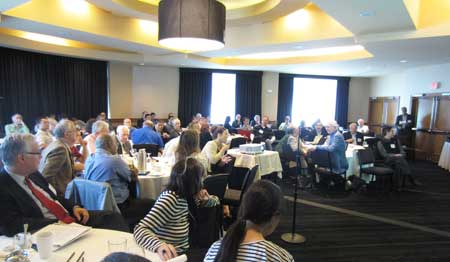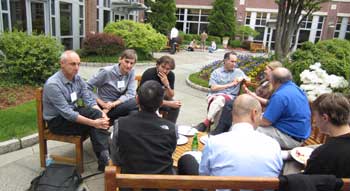Over 70 MIT faculty and 50 MIT staff gathered on May 17, 2013 to participate in the Office of Digital Learning's daylong meeting on technology-enabled education at MIT.
Task Force Reports
The morning featured chairs of the digital learning task forces reporting on aspects of 21st century learning such as video, learning spaces, assessment, research, hands-on learning, games, graduate education and concept mapping.

From rethinking the 90-minute lecture to ‘re-chunking’ learning blocks into shorter clips, video modalities at MIT range across lecture capture, animation, narrated presentations, voiceovers with whiteboards, and mash-ups. Recommendations included the need for more support to faculty who are editing and processing video which is time-consuming.
Hands-on learning at the institute is supported through portable kits, rapid prototyping, online labs, simulations and visualizations, with guided inquiry as a crucial component of meaningful learning. The gap between institutional support for prototypes and foundational/government support for proven initiatives offers ODL the opportunity to provide an intermediary role.
Games are an effective way to structure exploratory learning by engaging learners in a personalized context, providing customized feedback and motivating skills acquisition. Currently used at MIT in STEM context there is potential for games to be used in P-sets, assessments, augmented reality, and flipping the classroom.
Learning spaces at MIT need to be more deeply integrated with teaching, and should reflect student study habits, which more and more lean towards informal collaboration. Multi-purpose rooms are easily reconfigurable and support different learning environments.
In regards to effective use of learning modules and fundamental concepts, there is an opportunity for ODL to play a role supporting a repository of re-usable educational objects. Combined with analysis of student behavior, an interrelated collection can reflect student needs across the STEM curriculum.
Student assessment should reflect the emergence of 21st century skills. Assessment-based help should integrate learning with assessment. In addition, peer learning, data analysis and eye-tracking serve to inform and refine assessment techniques and goals.
Graduate Education must reflect emerging trends in learning. A certificate program in digital learning can prepare TAs for effective work in that realm and ODL can serve as a clearinghouse for best practices in digital learning. Peer review of graduate work should extend globally and across universities and thesis media needs to expand to digital formats.
In the area of basic research, the types of research on digital learning at MIT should expand, as well as access to relevant data. Data from edX must be curated as a public trust and FERPA must balance student privacy needs with the promise of educational research.
After the task force presentations, a large group discussion ensued, exploring how the ‘nuggetizing’ of subjects may impair intellectual capacity for deep, sustained engagement. In addition, a close look at 21st century learning goals revealed that at their core they are largely unchanged from past norms, but perhaps now they are achieved through different methods. Finally, the effort to eliminate silos in academia may be impossible as academia is inherently rooted in competition, and thus sequestration is inevitable. Lastly, pragmatics in regards to the scarcity of time for faculty makes exploring innovation in teaching difficult. ODL can play a concierge role or supply a ‘point of contact’ website that shares knowledge, services, and tools.

MITx Significant Interest Group
The afternoon continued with teams that are working with MITx as a course platform for both MOOCs and for residential education, sharing on aspects related to implementing and running a MOOC.
Advice for first-time instructors included ways to use the MITx platform for pre-assignments, homework, or an entire course. Taking small steps, knowing one’s audience, recycling content and building community are ways to effectively engage with MITx.
The challenges presented when translating a classroom-based course to an online MOOC include: gathering a large enough team to do the work, gauging the level of expertise of online students, clearly communicating goals and pre-requisites, finding ways to engage learners, and targeting tutorials that are interactive and proactively address misconceptions.
The use of tablets to narrate while drawing presents opportunities and caveats. Best practices include developing material dynamically. However, care should be taken to record only one slide at a time for efficiency and avoid messy diagrams.
Designing assessments for a MOOC requires targeting specific assessment goals: comprehension, mastery, skills, or connection to the material? Can assessments be recast to work with an automatic grader? How to implement forums effectively to reflect core pedagogical goals of the course?
Once the course is launched, time management is key, make sure one’s team can handle the work is crucial as well as catching and fixing issues as they appear. Minor issues un-solved can mushroom. Software in a MOOC can be used for problem solving, comprehension, or as a tool for a project or assignment. Extensive pre-testing is critical. Once in production, it can be that reported bugs are actually miscomprehension.
Instructor presence in a MOOC can range from occasional comments in a forum to weekly video messages. In MOOCs little professorial input goes a long way. In addition, Forums can be moderated by TAs. Skyped office hours for select students can be recorded and made available to the rest of the class vie video and transcript. Weekly hot topics should be selected from the forums and sent to the professor for response. However, a more efficient system is needed for trolling through huge numbers of forum posts as currently it is time-consuming for TAs.
Key components to successful MITx experiences include hands-on opportunities, adequate staffing, and timely help throughout the course. Harnessing students to be peer teachers as well as learners (learn one, do one, teach one) reinforces understanding, synthesis and demonstrable skills.
The afternoon concluded with roundtable discussions on the support and resources faculty would need to ensure a successful MITx course. Several groups reported the desire for a more efficient and user-friendly technology platform. Others re-iterated the larger-than-expected workload and need for adequate staffing, both in content development and platform configuration. Others focused on forming re-usable libraries, creating a community of practice, and the need for standards across the MITx/edX platforms.
To learn more about the Office of Digital Learning and MITx, please visit their websites.